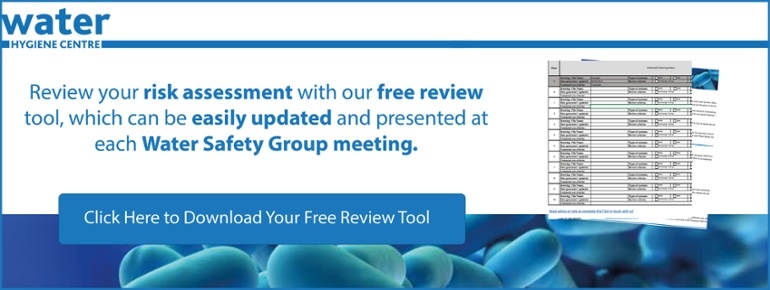These blogs are well-received by our followers and also prompt thoughts and questions from the reader. To put it simply, these thoughts and questions do come into the office seeking a response. This blog aims to address questions we’ve received, seeking clarification on the roles undertaken by the Dutyholder and the Responsible Person (Water).
Legionella - What does the law tell us?
The Dutyholder
Health and Safety at Work etc. Act 1974 refers to a person “who has, to any extent, control of premises” as being the Dutyholder.
The HSE’s ACoP L8 has a ‘quasi-legal’ status in that it is not ‘law’ but published guidance on approaches to manage the risk of Legionnaires' disease. L8 refers to “employers and those with responsibilities for the control of premises, e.g., landlords”
Roles & Responsibilities…
The Dutyholder is either the employer or the person in control of the premises, i.e., the Owner, chief executive, board of directors, or others who are ultimately responsible.
To comply with their legal duties, the Dutyholder should:
 Identify and assess sources of risk;
Identify and assess sources of risk;- Prepare a Legionella Written Scheme of Control for preventing or controlling the risk;
- Implement, manage, and monitor precautions;
- Keep water safety records of the precautions;
- Appoint a competent person, known as the ‘Responsible Person’.
The Dutyholder carries the ultimate responsibility for a safe and secure workplace environment. However, aspects of that responsibility can be assigned/delegated to other appointed individuals within an organisation.
In practice, many organisations appoint a Responsible Person (Water), who carries out the roles and responsibilities listed above. The Dutyholder will give that responsibility (through a formal letter of appointment) to them, but cannot relinquish the accountability.
The Responsible Person (Water)
HSE’s ACOP L8 describes the Responsible Person as “a competent person or persons to take day-to-day responsibility for controlling any identified risk from Legionella bacteria”.
ACOP L8 clearly states that it is essential that the Responsible Person has;
 Sufficient authority, competence, and knowledge of the installation to ensure that all operational procedures are carried out effectively and in a timely way;
Sufficient authority, competence, and knowledge of the installation to ensure that all operational procedures are carried out effectively and in a timely way;- Those specifically appointed to implement the control measures and strategies should be suitably informed, instructed, have completed Legionella training, and their suitability assessed;
- They must be adequately trained to a level that ensures tasks are carried out in a safe, technically competent manner, and regularly refresh their water hygiene training;
- Keep records of all initial and refresher training.;
- The appointed responsible person should have a clear understanding of their role and the overall health and safety management structure and policy in the organisation.
Depending on the organisation, its structure and size, other responsibilities for the Responsible Person may include:
 Chair the Water Safety Group (WSG) – ensuring papers and evidence are collated and issued promptly;
Chair the Water Safety Group (WSG) – ensuring papers and evidence are collated and issued promptly;- Work closely with other professionals within the WSG and external to the organisation, i.e. Government Bodies & Agencies, Water Hygiene Companies, and Authorising Engineer (Water) / External Water Hygiene Companies;
- Identification of potential risk areas or systems that are non-compliant;
- Ensure Legionella risk assessments are continually reviewed along with agreed action plans, updated as required;
- Development of the Water Safety Plan and ongoing review;
- Establish monitoring and compliance reporting processes;
- Auditing and verification processes are established and are being delivered.
If a Dutyholder is self-employed or a member of a partnership, and is competent, they may appoint themselves. However, it is not merely a matter of appointing themselves; they need to ensure they are suitably trained and know the risks involved.
This may be challenging for a Dutyholder; however, all is not lost. ACOP L8 details that the Dutyholder may appoint someone from outside the organisation to deliver on the role. Although the Dutyholder must ensure the competency of the person carrying out the role, they must clearly define their responsibilities, including lines of communication, in writing.
Multiple Duty Holders?
The HSE’s HSG274 Part 2 identifies the possibility of multiple Dutyholders. Where buildings have landlords, leaseholders, or tenants, an agreement must be in place detailing the responsibilities of each party. Examples of these situations include;
 Landlord and single leaseholder/tenant – either party could take full responsibility, or it can be shared;
Landlord and single leaseholder/tenant – either party could take full responsibility, or it can be shared;- Multiple tenants – owner remains Dutyholder or takes common areas only, and tenants take their areas;
- Managing agent – agreement to specify responsibilities.
If no agreements or contracts are in place, then whoever has control of the premises retains all responsibility.
In all instances…
Those individuals within an organisation with key management responsibilities should be identified, along with their defined roles and responsibilities. Communication pathways are valuable tools to help map out an organisation’s structure. All relevant parties shall fully understand the actual and potential risks associated with water safety and the concept of risk management.
Although compliance and management responsibility for Legionella management tasks may be delegated to others or undertaken by external contractors, accountability cannot be delegated by the Dutyholder.
Feel free to reach out if you have any questions about this blog or if you would like to consult with one of our experts for further advice on water hygiene.
Editor's Note: The information provided in this blog is correct as of the date of original publication – September 2022. (Revised August 2025)
© Water Hygiene Centre 2025









